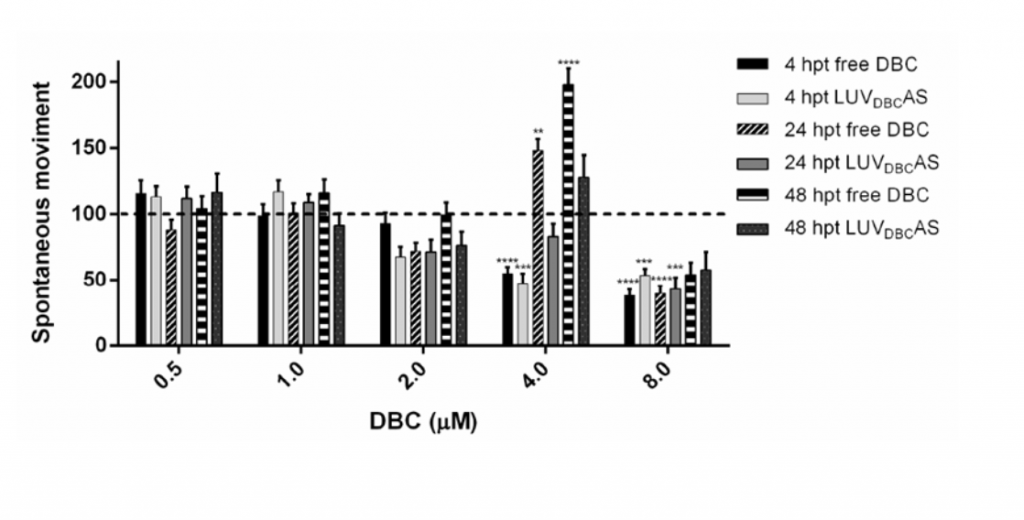
Administration of local anaesthetics (LA) is one of the most effective pain control techniques for postoperative analgesia. However, anaesthetic agents easily diffuse into the injection site, limiting the time of anaesthesia. One approach to prolong analgesia is to entrap LA in nanostructured carriers (e.g. liposomes). Dibucaine (DBC) is an amino-amide LA of high potency. It is mainly used as a topical active agent, in haemorrhoid creams and ointments. Additionally, in vitro (3T3 cells in culture) and in vivo (zebrafish) toxicity assays revealed ionic-gradient liposomes were able to reduce DBC cyto/cardiotoxicity, as well as morphological changes in zebrafish larvae.
Materials And Methods:
To evaluate the effect of increasing DBC concentration on zebrafish locomotor activity, The larvae were recorded for 15 min at 4 h, 24 h, and 48 h post treatment (hpt) with dibucaine (free or in the liposome formulation) in the WMicrotracker system. Motor activity was calculated as the sum of the activity events during 15 min, relative to the control. Experiments were performed three times, on eight larvae per group (n = 24).
Results:
This test evaluated the behavioural effects of DBC on spontaneous swimming of zebrafish larvae at 4, 24 and 48 hpt. Figure 6A shows that at lower DBC doses (0.5 to 2 μM) free DBC and LUVDBCAS did not significantly change larvae spontaneous movement (expressed as a percentage, relative to the control: untreated larvae). Larvae treated with 4 μM DBC presented hypoactivity at 4 hpt, but at 24 hpt and 48 hpt they showed hyperactive behaviour. This change of motor activity was not evident for LUVDBCAS at 24 and 48 hpt. Here the treatment with 0.5–4 μM DBC did not cause deep anaesthesia, since the larvae were able to react to mechanical stimulus (data not shown). Therefore, any change in behaviour caused by DBC with the 0.5–4 μM doses can be related to DBC neurotoxicity, and LUVDBCAS seemed to attenuate it. The zebrafish model was especially useful for evaluating both the local and systemic toxicities of the anaesthetic and the use of this ionic gradient- based liposome formulation for the sustained release of dibucaine.

Figure 6: A) Percentage of spontaneous movement of zebrafish larvae treated with dibucaine (free or
encapsulated in LUVDBCAS) for 4, 24 and 48 (n = 24). Statistical analysis was performed by One-way
ANOVA/Dunnett with significance of *p<0.05; **p<0.01, ***p< 0.001 and ****p<0.0001, compared to the control (non-treated larvae).
J Pharm Sci. 2018 May 23. pii: S0022-3549(18)30314-9. doi: 10.1016/j.xphs.2018.05.010.
Couto VM, Prieto MJ, Igartúa DE, Feas DA, Ribeiro LNM, Silva CMG, Castro SR, Guilherme VA, Dantzger DD, Machado D, Alonso SDV, de Paula E.
